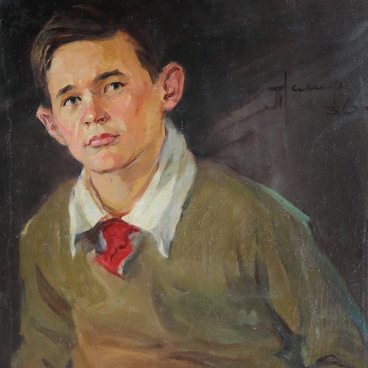Yekaterina Vladimirovna Gilyova was a Ural graphic artist and illustrator. She was born into a peasant family in Irbit. Gilyova studied in Sverdlovsk and then worked for a newspaper in Niznhy Tagil, drawing sketches at building sites, factories, and mining plants. In 1935, Gilyova moved to Sverdlovsk and was hired as an illustrator by a publishing house. She created drawings for children’s books, by Ural authors in particular, including Pavel Petrovich Bazhov. Gilyova first illustrated Bazhov’s stories as early as 1930.
During the Great Patriotic War, Yekaterina Gilyova had to take a break from literature: she started working in a hospital and making illustrations for propaganda posters, cards, and leaflets.
When the war ended, she resumed her career as a book illustrator, getting more and more orders for Bazhov’s works. Her drawings appeared alongside his famous stories, such as “The Malachite Box”, “The Snake Trail”, “The Fire-Fairy”, and “The Blue Snake”. On more than one occasion, Pavel Bazhov mentioned Gilyova among those artists who managed to truly capture the essence of Ural tales and the mood of their characters.
Yekaterina Gilyova had great illustrating skills that helped her create accurate and spot-on imagery, render the anatomy and plasticity of figures perfectly, as well as depict the personalities of the characters and the relationships between them.
In the early 1960s, Gilyova took a liking to countryside landscapes. The motifs in her studies were far from exotic, however, the audience was mesmerized by the ordinary yet cheerful realization: everything in nature was equally significant, no matter what season, time of day, or state of things it was. Gilyova’s watercolors were dense and had a high level of color saturation.
When Gilyova moved to the village of Borodulino in the Sysertsky district of the Sverdlovsk Oblast, her fascination with the local views led to the “Borodulino series” being a significant part of the artist’s oeuvre.
At present, the Irbit State Museum of Fine Arts houses hundreds of Gilyova’s works made over decades in different techniques — mainly book illustrations and easel graphics. The graphics include a number of portraits, genre sketches, and landscapes.
This charcoal self-portrait shows Gilyova with a serious expression, an attentive look, and a shoulder-length haircut with locks curled at the ends — the hairstyle that was in fashion at the time. The portrait was made in 1943 when the artist was 36 years old.
During the Great Patriotic War, Yekaterina Gilyova had to take a break from literature: she started working in a hospital and making illustrations for propaganda posters, cards, and leaflets.
When the war ended, she resumed her career as a book illustrator, getting more and more orders for Bazhov’s works. Her drawings appeared alongside his famous stories, such as “The Malachite Box”, “The Snake Trail”, “The Fire-Fairy”, and “The Blue Snake”. On more than one occasion, Pavel Bazhov mentioned Gilyova among those artists who managed to truly capture the essence of Ural tales and the mood of their characters.
Yekaterina Gilyova had great illustrating skills that helped her create accurate and spot-on imagery, render the anatomy and plasticity of figures perfectly, as well as depict the personalities of the characters and the relationships between them.
In the early 1960s, Gilyova took a liking to countryside landscapes. The motifs in her studies were far from exotic, however, the audience was mesmerized by the ordinary yet cheerful realization: everything in nature was equally significant, no matter what season, time of day, or state of things it was. Gilyova’s watercolors were dense and had a high level of color saturation.
When Gilyova moved to the village of Borodulino in the Sysertsky district of the Sverdlovsk Oblast, her fascination with the local views led to the “Borodulino series” being a significant part of the artist’s oeuvre.
At present, the Irbit State Museum of Fine Arts houses hundreds of Gilyova’s works made over decades in different techniques — mainly book illustrations and easel graphics. The graphics include a number of portraits, genre sketches, and landscapes.
This charcoal self-portrait shows Gilyova with a serious expression, an attentive look, and a shoulder-length haircut with locks curled at the ends — the hairstyle that was in fashion at the time. The portrait was made in 1943 when the artist was 36 years old.




